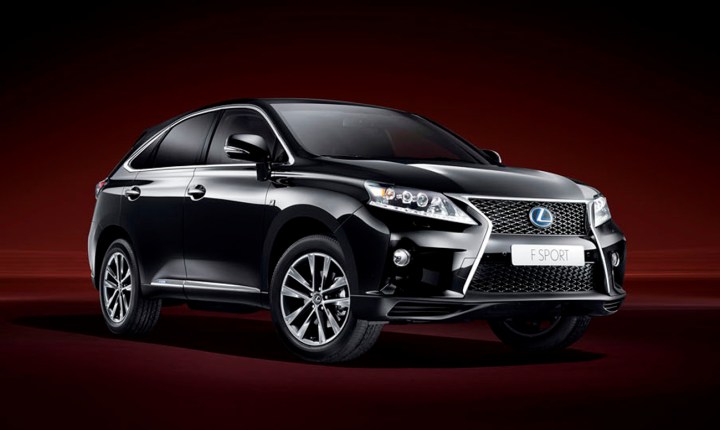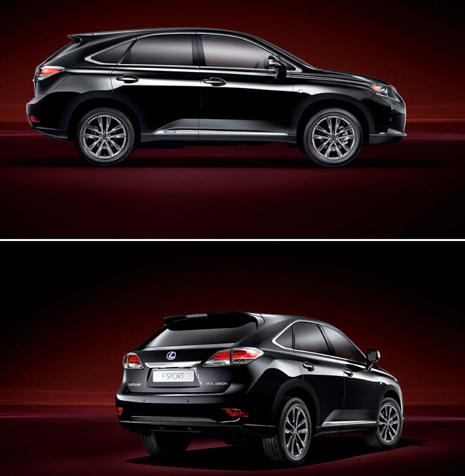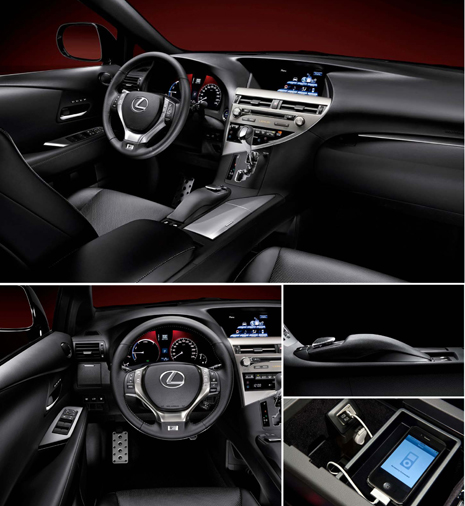Maverick Life
Lexus RX450h: Off-roading’s oxymoron

If there is one vehicle category guaranteed to raise the hackles of the bunny huggers, it is the segment populated by those large, bruising SUV so cherished by South Africans. Not only do these juggernaut 4x4s have an insatiable thirst for fuel, while spewing kilograms of noxious CO2 emissions to match, but they also enable their callous owners to bundu bash to their heart’s content. So why should the Lexus RX450h F-Sport be any different? By DEON SCHOEMAN.
Mother Earth is heating up. Oil prices are rising steadily (even if the current dip suggests otherwise). Crude reserves are dwindling. And fuel has never been more expensive.
No wonder there’s an increasing realisation that environmental conservation is no longer just for misty-eyed idealists and vociferous radicals. Saving the planet has become a call to eco arms for a fast-growing lobby of increasingly vocal, deeply concerned citizens.
It’s a situation that shouldn’t augur well for those folk who enjoy their motoring big and bad and brawny, preferably with all four wheels churning, while perched high and mighty on a jacked-up suspension.
And yet there’s no shortage of supersized all-wheel drive machines on local roads – even if many spend more time mounting nothing more challenging than a shopping mall kerb, or a pesky traffic island. Nor does the demand appear to be tapering off.
Lexus believes there’s a way to find a compromise between the seemingly incompatible agendas of those with a green conscience on the one hand, and petrol-headed 4×4 enthusiasts on the other. It’s called the RX450h.
Hybrids are supposed to be more eco-friendly because they don’t rely on conventional fuel alone for their motive urge: they rope in electric power to supplement the conventional engine on board, and save fuel in the process.
Reducing fuel consumption also means lower CO2 emissions – and suddenly that thirsty, dirty 4×4 beast becomes more socially acceptable. At least, that’s the theory. But does it pan out in practice?
This latest Lexus RX450h has only just reached showroom floors, and while the mechanical underpinnings have remained largely the same, there’s been some nipping and tucking to the exterior, together with some brushing up of the interior.

If you know your Lexi from your BMWs and Mercs, you’ll also notice a new badge, announcing that this RX450 is a F-Sport derivative. Until now, the F-Sport badge has been restricted to some of the Lexus road cars, most notably the lardy CT200h hatchback, and the dashing, new-generation GS350 I wrote about not that long ago.
So, the RX450h isn’t only green – it’s meant to be sporty too? Frankly, that sounds to good to be true.
The exterior styling, quintessentially SUV in approach, has been garnished with some edgier kit to provide visual confirmation of the RX450’s F-Sport status. Most obvious are the front-end changes, which incorporate the addition of what Lexus calls its new spindle grille. The new look debuted on the GS350, and is likely to find its way to the entire Lexus family.
The newly sculpted grille is flanked by equally dashing headlight clusters, now emphasising the cleaner outlines of the air intakes, and fitted with the obligatory, LED-illuminated daytime running lights. At least they’re neatly integrated here, and not stuck on as a slapdash afterthought.
As this is the new F-Sport version, the entire front is more aggressively executed, with the grille gaining a black mesh design, outlined in chrome. The deeper airdam culminates in cooling apertures just ahead of each front wheel arch.
The focus on athletic aesthetics is extended to the accentuated side sills and the contoured rear bumper. Generous, 19-inch alloys finished in chic anthracite, and shod with low-profile, road-biased 235/55 rubber, provide the finishing touch.
The result is neatly understated and subtle, with just enough visual sparkle to attract attention without bragging out loud.

The air of F-Sport exclusivity continues in the plushly appointed cabin. Let’s not forget that Lexus is a luxury nameplate first and foremost, and the RX450h leaves its occupants wanting for nothing in the creature comfort department.
The F-Sport treatment includes a grippier, sportier three-spoke steering wheel, with a full complement of multifunction controls. But the shift paddles I thought would have been a given in this context are notable only by their absence. We’ll get to that later, though.
The remainder of the cabin is pure, sumptuous Lexus, which is not a bad thing. There’s loads of space front and rear, and the front seats are electrically adjustable, and extremely comfortable.
The dashboard looks busy at first, but once you’ve identified the key control zones, everything’s pretty easy to find, and within convenient reach. The deep-set analogue dials are clearly legible, while also confirming the 450h’s hybrid status: the rev counter has been replaced by a charge/power mode indicator.
There’s a central, multi-function colour display that looks like a touchscreen at first, but is well outside the driver’s reach. Instead, you select and highlight virtual buttons on the screen with a mouse-like device on the centre console.
Innovative? Certainly. Practical? Hardly. The mouse is sensitive to the slightest movement, and requires both dexterity and precision to operate accurately. Since it’s located in the centre console, you need to operate it with your left hand – awkward unless you happen to be left-handed.
It smacks of gadgetry, and offers no tactile benefits over the more conventional control interfaces offered by the RX450h’s rivals.
But that ergonomic faux pas apart, there’s very little to fault inside the Lexus. It oozes comfort and well-being, cosseting its occupants in fine-grain leather, heating the seats on chilly mornings, playing music through a nicely tuned multi-speaker system, and keeping the cabin at just the right temperature, regardless of the ambient conditions.
But what about the apparent dichotomy between the dynamic expectations created by that F-Sport designation, and the frugal, responsible aura implied by the RX450h’s hybrid drivetrain?
Let’s deal with the latter expectation first: the F-Sport adds very little, if anything, to the RX450h’s dynamic capabilities. Yes, stiffer coil springs, lower-profile tyres and the fitment of front and rear anti-roll bars have tidied up the handling, but it still feels the large and comfortable SUV part.
The hybrid aspect is very real, however, and constantly impacts on the overall driving experience. As with the previous model, this RX450h combines a 3,5-litre, Atkinson-cycle petrol V6 with two electric motors – one in front, and the other at the rear. Cleverly, the rear motor also provides the SUV’s intelligent all-wheel drive.

The V6 works in tandem with the two electric motors and a battery pack to provide a seamless power delivery. And if you thought hybrid vehicles were anaemic, think again: the RX450h is meant to rival a V8 in power and torque terms, while achieving consumption and emissions figures well below the V6 norm.
The hybrid drivetrain’s muscle is considerable. The petrol V6 is rated at 183kW and 317Nm, which is substantial enough. However, the front and rear electric motors contribute a further 123kW/335Nm and 50kW/139Nm respectively, ensuring almost instant shove – despite a 2.2-ton kerb weight.
In that context, the big Lexus has surprising get up and go. The 0-100 km/h dash is despatched with almost regal impunity in just 7,8 seconds, while the top speed is an effortless 200 km/h.
The power delivery is smooth and consistent, rather than explosive, which understates the dynamic experience, but suits the SUV’s effortless demeanour. I wouldn’t call it sporty, but it’s no slouch, and overtaking is a cinch.
Pity then that the experience is aurally challenged by the standard constantly variable transmission (CVT), which makes the engine whine like a jet engine, and creates the uncomfortable illusion of a slipping clutch in the process.
CVTs may be efficient and smooth, but they’re not nearly as user-friendly as conventional auto boxes. Besides, creating a set of stepped, virtual gears accessed sequentially using shift paddles (a common practice with many brands) would have been a far more engaging solution.
But the hybrid drivetrain’s real focus is on efficiency, and the claimed fuel consumption figures appear to vindicate this, with a combined-cycle figure of just 6.3-litres/100km, and a CO2 emissions rating of 148g/km.
It achieves this by allowing the electric motors to supplement output. The motors are powered by the battery pack, which is recuperatively charged every time you coast, or brake. With a full battery, you can even drive in electric-only, zero-emissions EV mode, albeit for a short distance only.
The consumption statistics are impressive for a big, heavy all-wheel drive SUV, even if the 4×4 drive is only part-time and on-demand. That our real-world test consumption was considerably thirstier, at 8.9-litres/100km, doesn’t detract from the fact that the Lexus is a lot more frugal than one would expect.
Let’s also debunk any expectations of its off-road capabilities. While it has a slightly elevated ride height, and while the rear motor can provide rear-wheel traction, this Lexus is more soft-roader than gung-ho 4×4. It won’t cope with much more than rutted gravel: mud, deep sand and water need to approached with caution.
On tar or smooth gravel, the RX feels serene and composed, with enough suspension give to make short work of irregularities. Pressing on, there’s less lean than anticipated, while the rear’s extra traction adds further confidence and control.
What we have then, is a big SUV with an even bigger dynamic heart, but without the usual appetite for premium unleaded. Think Victor Matfield pecking on a garden salad before a big game, and you’ll get the general idea.
Does that make it more eco-acceptable? Probably – as long as people recognise and acknowledge its hybrid status, and the resultant reduction in fuel consumption. But we’re talking in relative terms, here: what’s good in the SUV context still doesn’t cut it as planet-saver.
And there’s the rub. Large SUVs, even hybrid ones, will always have a bigger carbon footprint than small, frugal runabouts, not only because they’re thirstier and more powerful, but also because it takes more resources to build and sustain them.
The Lexus RX450h is not the answer to global warming. But it’s a clear, compelling (and expensive!) glimpse of a more frugal motoring future that may still be able to accommodate the SUV segment, after all. DM
|
Lexus RX450h F-Sport Engine: 3,456cc V6 + dual electric motors Gearbox: CVT Combined power: 183kW @ 6,00rpm + 173 kW Combined torque: 317Nm @ 4,800rpm + 474 Nm 0-100 km/h: 7.8sec Top speed: 200km/h Fuel consumption: 6.3-litres/100 km CO2 emissions: 148 g/km Retail price: R755,000 |















 Become an Insider
Become an Insider